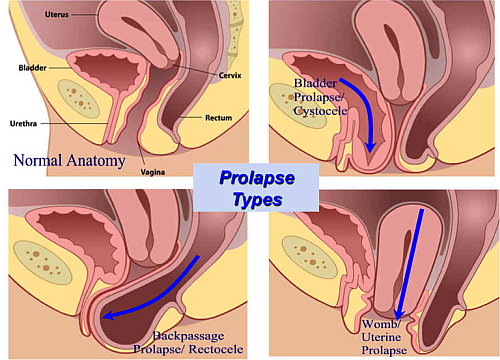𝑯𝒐𝒘 𝒅𝒐 𝑰 𝒌𝒏𝒐𝒘 𝒊𝒇 𝑰 𝒉𝒂𝒗𝒆 𝒂 𝒑𝒓𝒐𝒍𝒂𝒑𝒔𝒆?
- A prolapse is when one of your pelvic organs, such as bladder, bowel or uterus slips from the normal position and bulges into the vagina

- There are a variety of symptoms. Some women never have any trouble from a prolapse. Others may experience:
- A heaviness or dragging sensation down below
- Feeling a bulge below or like you are sitting on a ball
- Difficulty passing urine, which may include stress incontinence or feeling like you couldn’t empty your bladder completely
- Difficulty opening your bowels without putting a finger into the vagina
If you have the above symptoms then see your GP who can perform an initial examination and decide where to refer you.
𝑾𝒉𝒂𝒕 𝒂𝒓𝒆 𝒎𝒚 𝒐𝒑𝒕𝒊𝒐𝒏𝒔?
There are a number of treatments to try before considering surgery. The most effective are lifestyle changes, such as stopping smoking and losing weight.
Other options include vaginal pessaries and surgery.
𝑻𝒐 𝒘𝒉𝒂𝒕 𝒆𝒙𝒕𝒆𝒏𝒕 𝒄𝒂𝒏 𝒑𝒉𝒚𝒔𝒊𝒐 𝒉𝒆𝒍𝒑?
Im very grateful to @clarebournephysio for her top tips on this:
The focus of our work is on symptoms and not on prolapse grade. A large study called the POPPY trial concluded that one-to-one pelvic floor muscle training for prolapse is effective for improvement of prolapse symptoms. However, it can also change the grade of prolapse, especially with a cystocele, but the focus is always on symptoms
𝑾𝒉𝒂𝒕 𝒄𝒂𝒏 𝒘𝒐𝒎𝒆𝒏’𝒔 𝒉𝒆𝒂𝒍𝒕𝒉 𝒑𝒉𝒚𝒔𝒊𝒐 𝒐𝒇𝒇𝒆𝒓?
At your first appointment they will assess the prolapse by vaginal examination in lying and standing. Most women are symptomatic in standing.
They will then take you through a supervised training programme for a minimum of 16 weeks. They will teach you exercises will include pelvic floor, deep core and global exercises such as glutes to help full pelvic stability.
If you need additional help to contract your pelvic floor they may suggest stimulation, or biofeedback devices that you can use at home. They will also help you understand the best exercise and work with you towards individual goals.
